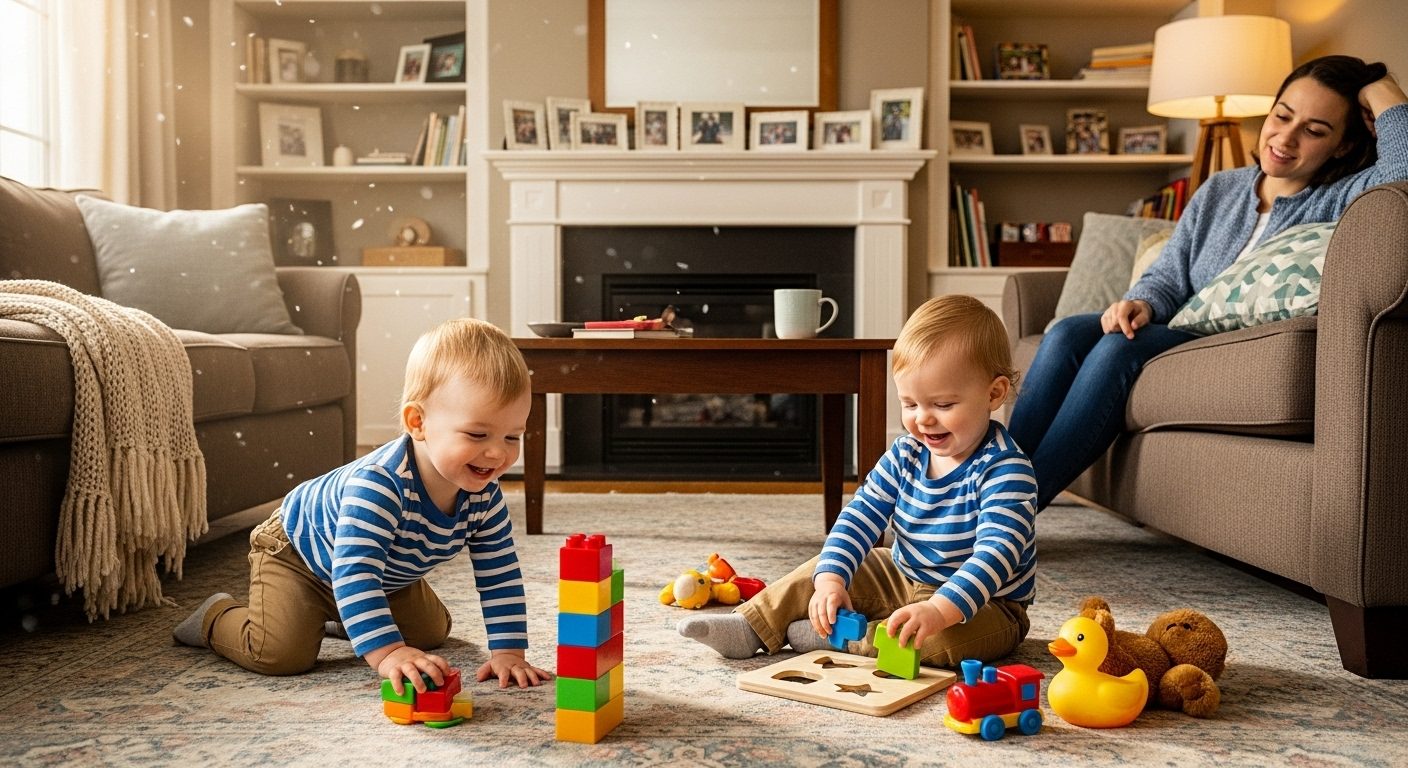Remember that moment when the ultrasound tech paused, squinted at the screen, and said those life-changing words: “I’m seeing two heartbeats”? Yeah, me too. My brain immediately went from “Yay, we’re having a baby!” to “Wait… TWO babies? At the SAME TIME?!”
If you’re reading this with twins on the way—or already juggling two tiny humans who somehow need feeding, changing, and soothing simultaneously—I see you. I’ve been there, standing in the baby aisle at 2 AM with two screaming infants, wondering if I’d accidentally signed up for an extreme sport instead of parenthood.
But here’s what I’ve learned after surviving (and actually thriving through) the twin parenting experience: it’s not just double the work. It’s also double the giggles, double the milestones, and yes, double the love that fills your heart in ways you never imagined.
Let me share what I wish someone had told me before I brought my dynamic duo home.
The First Few Months: Survival Mode Activated
Real talk: Those early days with twins are intense. While singleton parents are learning to care for one baby, you’re essentially running a 24/7 infant care facility with a staff of… well, you (and maybe a very exhausted partner).
Creating Your Twin Care System
The secret to surviving twin infancy isn’t superhuman strength—it’s having a system. Here’s what worked for our family:
The Feed-Sync Strategy: I learned quickly that tandem feeding (feeding both babies at once) was my lifeline. Whether you’re breastfeeding or bottle-feeding, getting them on a similar schedule saves your sanity. Sure, it feels impossible at first—I spent many nights with a twin football hold that would make any quarterback jealous—but it means you actually get some sleep between feedings.
The Color Code Trick: Each twin got their own color. Everything—bottles, pacifiers, blankets, even onesies—was either blue or green. This simple system helped us track who ate what, who needed changing, and which medication went to whom during those sleep-deprived fog days.
The Diaper Station Battalion: I set up changing stations on every floor of our house. Nothing worse than being upstairs with two babies who both need changes and realizing all the diapers are in the nursery downstairs. Trust me, learn from my mistakes!
Sleep (Or the Mythical Concept Thereof)
Everyone warns you about sleep deprivation with one baby. With twins? Multiply that by… well, more than two, honestly. But there’s hope!
The Synchronized Sleep Dance: Getting twins on the same sleep schedule is like conducting a very fussy orchestra. When one wakes for night feeding, I’d wake the other too. Sounds counterintuitive, I know! But it meant they’d (eventually) sleep during the same windows, giving me actual rest periods instead of back-to-back baby duty.
The White Noise Miracle: Two babies means double the noise that can wake each other up. A good white noise machine became our household MVP. It helped them sleep through each other’s fussing and created a consistent sleep environment.
The Unique Bond: Watching Twin Magic Unfold

Here’s something amazing that singleton parents don’t get to witness: the twin bond developing. Around 3-4 months, I noticed my twins starting to track each other with their eyes. By six months, they were reaching for each other. Now? They have their own secret language, inside jokes, and an automatic best friend for life.
The Built-In Entertainment Factor: Once they could interact, everything changed. While other parents were constantly providing entertainment, my twins entertained each other! Sure, sometimes “entertainment” meant pulling each other’s hair or stealing each other’s toys, but mostly it meant I could actually drink a hot cup of coffee while they played together.
The Comparison Trap Warning: Every twin parent faces this—people constantly comparing your children. “Which one is bigger?” “Who walked first?” “Is she the smart twin?” Here’s my hard-earned wisdom: resist this completely. Your twins are individuals who happen to share a birthday (and maybe identical DNA). I made a conscious effort to celebrate each child’s unique timeline, just as I would with siblings of different ages.
Daily Logistics: The Practical Stuff Nobody Tells You
Getting Out of the House (The Ultimate Challenge)
Leaving the house with infant twins feels like preparing for a military operation. Here’s how I learned to make it work:
The Night-Before Routine: I’d pack the diaper bag, lay out outfits, and load the car the night before any outing. Morning-me was way too frazzled to remember everything.
The Tandem Stroller Investment: Yes, they’re expensive. Yes, they’re worth it. I went with a side-by-side model (better for narrow doorways than you’d think) and it became my freedom machine. Double stroller, double independence.
The Realistic Timeline: If I needed to be somewhere at 10 AM, I started getting ready at 8 AM. With twins, everything takes longer. Everything. Accept it, plan for it, and you’ll stress less.
Mealtime Madness (Now and Later)
The infant feeding frenzy eventually evolves into toddler food wars. When my twins started solids, I learned some tricks:
The Dual High Chair Setup: Side-by-side high chairs meant I could feed both simultaneously—one spoonful here, one spoonful there, like the world’s messiest tennis match.
The “Let Them Feed Themselves” Philosophy: Yes, it’s messier. Yes, more food ends up on the floor than in their mouths initially. But teaching both twins to self-feed early meant I wasn’t stuck playing airplane with two sets of mouths forever.
The Shared Meal Planning: I involved both kids in meal choices as they got older (within reason—we’re not having ice cream for dinner, twins). This reduced food battles and made them more willing to try new things because “my twin is doing it.”
Child Care Considerations for Twin Families
Our E-book
The Daycare Question
Finding child care for twins comes with unique challenges. Many facilities charge full price for each child (spoiler: they should, because it’s two children). Some offer twin discounts, which can help with the financial strain.
Quality Over Cost: I learned not to compromise on care quality to save money. My twins needed caregivers who understood their unique bond and individual needs. We found a small in-home daycare where the provider had twin experience—game changer!
The Separation Debate: Some experts suggest separating twins in daycare or school to foster independence. We tried both approaches. Initially together (they comforted each other during the transition), then separate classes as they got older. There’s no one-right-answer here—you’ll know what works for your family.
Building Your Support Village
The old saying “it takes a village” should be “it takes a small army” for twin parents. Don’t be afraid to ask for (and accept!) help.
The Meal Train: When well-meaning people ask “What can I do?”, say “Bring dinner!” Feeding yourself while caring for two infants is legitimately difficult.
The Specific Task Requests: Instead of vague offers to help, I started making specific requests: “Can you hold Baby A while I feed Baby B?” “Could you fold this laundry while I pump?” People want to help—they just need direction.
The Emotional Roller Coaster
Managing Mom Guilt Times Two
Twin parent guilt hits differently. You’re constantly worried you’re not giving each child enough individual attention, or that you’re favoring one over the other.
The One-on-One Time Strategy: Even 15 minutes alone with each twin made a huge difference. While my partner handled one for bath time, I’d read to the other. Then we’d switch. Those individual moments mattered more than I realized.
The “Good Enough” Mantra: Perfection is impossible with one child. With twins? Forget it. I learned to celebrate the small wins—everyone’s fed, everyone’s (relatively) clean, everyone’s alive. That’s a successful day!
Handling the Public Attention
Twins attract attention like magnets. Grocery store trips turned into impromptu Q&A sessions: “Are they twins?” “Are they identical?” “Do twins run in your family?” (My personal favorite eye-roll moment.)
The Polite Brush-Off: I developed a friendly but firm response for when I needed to actually accomplish errands: “Yes, they’re twins! We’re running late, but thanks for asking!” Most people respect the boundary.
The Teaching Moment: I used some of these interactions to teach my twins about being kind when people are curious but also setting boundaries when needed. It became a surprising life lesson opportunity.
The Toddler Years: Double Trouble (and Double Fun!)
The Synchronicity of Chaos
Remember when I said they’d entertain each other? Toddler twins take this to a whole new level. They team up, they scheme, they execute plans with military precision.
The Safety Double-Check: Twin-proofing goes beyond regular childproofing. Two minds working together can figure out how to defeat safety gates, open locked cabinets, and scale furniture you thought was un-scalable. Stay one step ahead (if possible).
The Teamwork Teaching: Instead of just disciplining their partner-in-crime behavior, I channeled it. “You two are great at working together! Let’s use that teamwork to clean up these toys.” Sometimes it actually worked!
Developmental Milestones: The Individual Journey
My twins hit milestones at completely different times, even though they shared a womb. One walked at 10 months; the other at 13 months. One talked early; the other communicated through twin language longer.
Celebrating Individual Progress: I kept separate baby books and celebrated each milestone individually. No comparisons, just pure joy for whoever was achieving what.
The Delayed Speech Consideration: Twin parents often worry about language development. Yes, twins sometimes develop their own language (it’s adorable and fascinating). But if you’re concerned about speech delays, don’t hesitate to get evaluated. Early intervention helps!
Managing the Financial Reality
Let’s talk money, because twins are expensive. Double of everything adds up fast.
Smart Shopping Strategies
The Twin Parent Networks: I joined online twin parenting groups and found local twin communities. The hand-me-down networks and gear-sharing saved us thousands.
The Strategic Buying: Some things you need two of (car seats, cribs). Some things you can share (toys, books, styling tools for quick hairstyles as they grow). Figure out which is which before buying duplicates of everything.
The Buy-in-Bulk Mentality: Diapers, wipes, formula—we bought everything in bulk. Yes, our garage looked like a warehouse, but the savings were real.
The Work-Life Calculation
Some twin parents find that the cost of childcare for two babies exceeds one parent’s salary. This creates tough decisions about careers and staying home.
The No-Judgment Zone: Whether you go back to work, stay home, work part-time, or cobble together a creative solution—there’s no wrong answer. We all do what works for our family’s situation.
Building Individual Identities
As my twins grew, I became increasingly aware of the importance of nurturing their separate identities.
The Dress-Alike Decision
I’ll admit—I dressed them identically as infants (it was adorable!). But as they developed preferences and personalities, I let them choose their own clothes. One loves dresses; the other lives in athletic wear. And that’s perfect.
The Different Activities Approach: When they were old enough, I encouraged them to try different activities. One does dance; the other plays soccer. They don’t have to share every interest just because they share DNA.
The Separate Friend Groups: While they have mutual friends, I also facilitated separate playdates and friendships. They needed space to be themselves, not just “the twins.”
The Twin Sibling Dynamic
The twin relationship is unlike any other sibling bond. They’ve literally never known life without each other.
Managing Twin Conflict
Yes, they fight. Sometimes more intensely than regular siblings because they’re together constantly and are used to sharing everything (including parents’ attention).
The Individual Discipline: When conflicts arose, I addressed each twin’s behavior individually rather than treating them as a unit. They needed to learn accountability for their own actions.
The Conflict Resolution Skills: Twins get lots of practice in negotiation, sharing, and working through disagreements. I framed their conflicts as opportunities to build these crucial life skills.
The Beauty of the Twin Bond
Despite the challenges, watching the twin bond develop has been the greatest privilege of my parenting journey.
The Automatic Support System: When one twin feels scared or uncertain, the other is there. They started preschool holding hands. They comfort each other during thunderstorms. They celebrate each other’s victories.
The Shared Memories: They’re creating a shared childhood that’s uniquely theirs. The inside jokes, the shared experiences, the memories they’ll carry together into adulthood—it’s something special.
A Family Matter: How Twins Change Family Dynamics
Having twins doesn’t just affect the twins—it affects your entire family structure.
For Other Siblings
If you have older or younger singleton children too, they need attention and understanding. I made sure to have one-on-one time with our singleton, and we talked openly about how twins get attention because there are two of them, but that doesn’t mean they’re more important or more loved.
For Your Partnership
Twin parenting tests relationships in unique ways. My partner and I learned to operate like a well-oiled machine, dividing and conquering. We also learned to give each other grace during the hard moments and celebrate the wins together.
The Date Night Necessity: We protected couple time fiercely. Even if it was just watching a show together after the twins slept, we prioritized “us.” Finding a babysitter willing to handle twins was challenging, but worth it.
Twin Care Tips for Different Ages
Newborn to 6 Months
- Master tandem feeding (your back will thank you)
- Get them on the same schedule ASAP
- Accept all help offered
- Sleep when they sleep (really!)
- Take videos of the tiny moments—they grow so fast
6 Months to 1 Year
- Baby-proof early and thoroughly
- Introduce solids simultaneously but respect different preferences
- Encourage individual self-soothing
- Celebrate separate milestones
- Take lots of photos (they’ll be mobile soon and photos get harder!)
Toddler Years (1-3)
- Set clear, consistent boundaries
- Provide individual attention daily
- Channel their teamwork positively
- Allow different interests to emerge
- Maintain sense of humor (critical!)
Preschool and Beyond
- Support separate friendships
- Discuss classroom placement thoughtfully
- Celebrate individual achievements
- Address comparison comments from others
- Foster their unique bond while nurturing independence
The Unexpected Joys
I want to end with the stuff that makes it all worthwhile, the moments that make twin parenting magical:
The Synchronized Giggles: When something strikes them both as funny and they dissolve into identical laughter—pure joy.
The Twin Defense Force: Watching them defend each other on the playground, standing up for their twin when someone is unkind.
The Secret Language: Those moments when they communicate in ways only they understand, sharing a bond that’s literally from the womb.
The Double Milestones: Yes, more work, but also twice the first steps, twice the first words, twice the pride.
The Instant Playmates: As they grew, they always had a friend, a partner in crime, a companion for adventures.
Your Twin Journey
Whether you’re expecting twins, currently in the trenches of twin infancy, or navigating the toddler tornado with two, know this: you’re not alone. There’s an entire community of twin parents who understand the unique challenges and joys.
It’s okay to feel overwhelmed. It’s okay to ask for help. It’s okay to serve cereal for dinner sometimes. It’s okay to lock yourself in the bathroom for five minutes of peace. You’re doing an incredible job raising two humans simultaneously—give yourself credit!
Motivational Summary
Twin parenting isn’t for the faint of heart, but it’s also not the impossibly overwhelming challenge it seems at first. You’ll develop systems that work for your family. You’ll learn to manage the chaos. You’ll discover reserves of patience and energy you didn’t know you had.
Most importantly, you’ll watch two incredible little people grow up together, forming a bond that’s unique and beautiful. The sleepless nights fade from memory, but the sound of their shared laughter, their inside jokes, their fierce protection of each other—those moments become the treasures of your heart.
Yes, twins are twice the work in those early days. But they’re also twice the love, twice the joy, and twice the blessing. And honestly? I wouldn’t change it for the world.
Final Wisdom
“Twins are miracles who come in pairs, to double your troubles and double your cares. But also to double your laughter and love, and fill your home with double hugs.”
Now, take a deep breath, give yourself grace, and remember: you’ve got this. And on the days when you feel like you don’t? That’s what the twin parent community is for. Reach out, share your struggles, celebrate your wins, and know that every twin parent before you has survived the chaos and lived to tell the tale.
Your twins are lucky to have you. Even on the days when everyone’s crying (including you), even when the house looks like a disaster zone, even when you’re wearing yesterday’s yoga pants and can’t remember when you last showered—you’re exactly the parent they need.
What’s your biggest twin parenting challenge right now? Drop a comment below and let’s support each other through this beautiful chaos! And if you found this helpful, share it with another twin parent who might need to hear they’re not alone.
P.S. If you’re wondering how you’ll ever manage styling two heads of hair simultaneously as they grow, check out these easy kid hairstyles any parent can master—they’ve saved me countless mornings.





